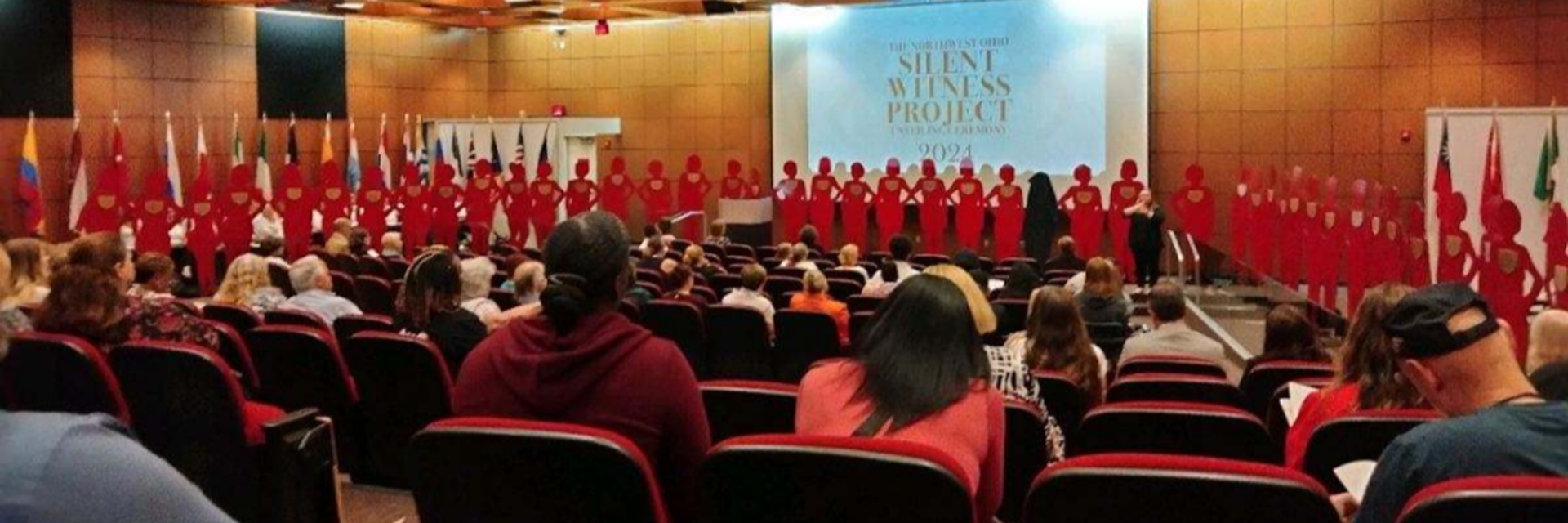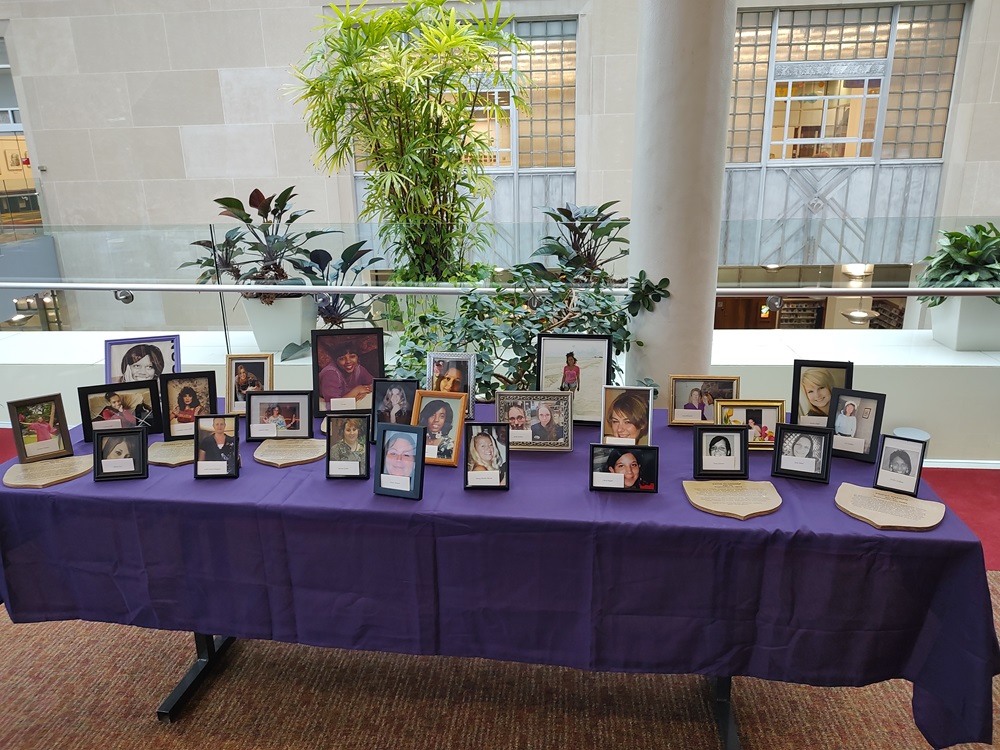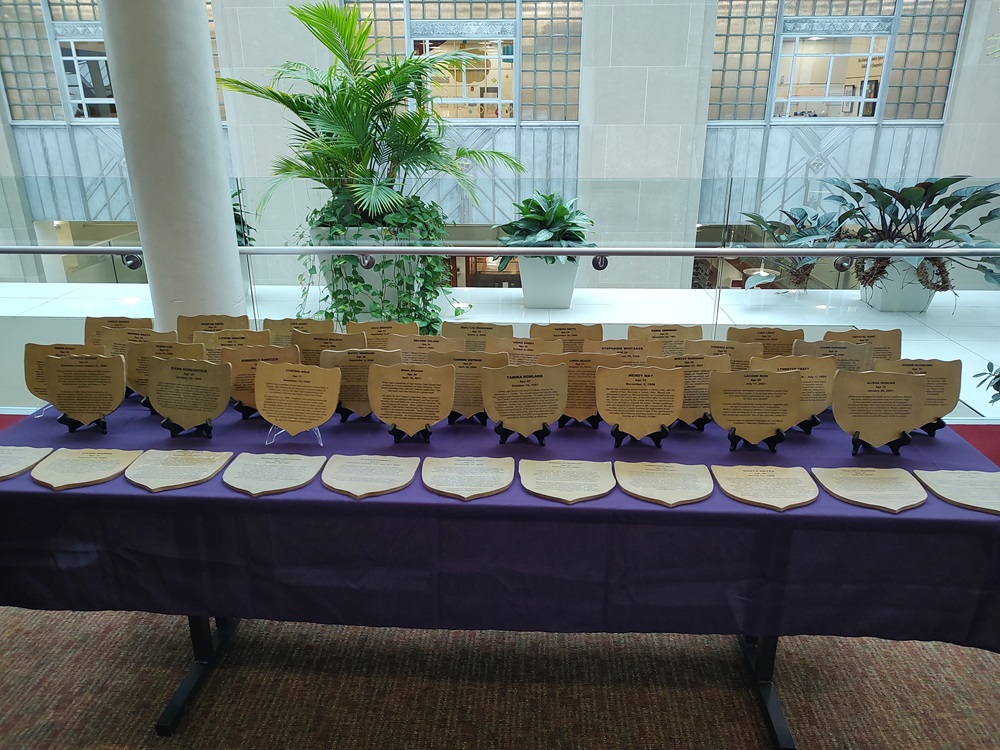
October is Domestic Violence Awareness Month, a time to reflect on the pervasive issue of abuse in intimate relationships and to honor the resilience of survivors.
This month serves as a reminder of the need for continued education, prevention efforts, and support systems that can help end the cycle of violence. By raising awareness and providing a platform for those affected to share their stories, we can work toward creating a society where everyone feels safe, respected, and empowered in their relationships.
Each year, we kick off Domestic Violence Awareness Month with the Northwest Ohio Silent Witness Project Unveiling Ceremony, memorializing women and girls who were killed in acts of domestic violence. Over the past decade, 44 such murders have occurred in our community.
Our 23rd annual ceremony took place on October 1, 2024 at the McMaster Center at the Main Branch of the Toledo Lucas County Public Library. More than 100 people gathered to remember the 44 women our community has lost to intimate partner violence. See the footage from WTOL below.
Mary O’Doherty, Executive Director of the Ohio Domestic Violence Network, delivered keynote remarks reflecting on the intersectionality of domestic violence and centuries of race and gender inequity.
In the early 1970s, the Women’s Liberation Movement set the stage for the Battered Women’s Movement and shelters began to open in significant numbers across the United States. Some mark that period as the beginning of the domestic violence movement. O’Doherty noted that while the “chronology makes sense in a narrow view, there are also important diversity, equity, and inclusion lessons to be learned from thinking about this history more broadly and through an intersectional lens,” exploring how systems of oppression interact and combine to create unique experiences of discrimination and privilege.
She invited the audience to consider that violence against women has long been a bedrock tool of white supremacy, that Indigenous and enslaved people weren’t counted as full human beings in the founding policies and laws of this country, that sexual violence against enslaved women was commonplace, and that the rape of a Black woman wasn’t widely considered a crime until after the Civil War. She pointed out that even the histories of the women’s equality and women’s suffrage movements are often told solely through the lens of White suffragettes – centering their views and glossing over the racism within those movements.
O’Doherty, herself a White woman with more than 23 years of experience in the domestic violence space, told the audience that she only recently learned that sexual violence against Black women was a catalyst in the civil rights movement.
Historian Danielle McGuire, in her book At the Dark End of the Street, tells the story of Recy Taylor, a 24-year-old mother, who was attacked and raped by a group of at least six White men in 1944, as she walked home from a prayer meeting in Abbeville, Alabama. The Montgomery NAACP chapter sent an investigator to interview Taylor – an activist by the name of Rosa Parks. McGuire contends that anger over a series of rapes and sexual assaults against Taylor and other Black women helped fuel the Montgomery bus boycotts and Parks’ now historic leadership in the civil rights movement.
Even today, O’Doherty explained, basic statistics about domestic violence conceal a deeper story of inequity and how intimate partner violence disproportionately affects people of color, particularly Black women. The most recent fatality report from the Ohio Domestic Violence Network, released in October 2023, counts all domestic violence homicides in Ohio from July 2022 through June 2023. There were 112 deaths due to domestic violence during that period, including 78 intended victims and 34 bystander victims.
By comparison, she noted, only 18% of Ohio’s population is Black or mixed race, according to the most recent Ohio census.
Reminding the audience that racism and power imbalances are alive and well in many of our institutions, O’Doherty issued a call to acknowledge those disparities and reflected that only by seeking to “understand the impact of generational trauma and centuries of inequality can we truly see what work of repair and transformation still needs to be done, and the urgency of that important, necessary work.”
To close the event, Stephanie Potter, Youth Program Coordinator at Bethany House, highlighted the need for everyone to take domestic violence seriously. “The impact on both adults and children is long-lasting,” she said, “and the stakes are incredibly high.”
Kicking off Domestic Violence Awareness Month by honoring the women and girls whose lives were violently taken remains important and impactful. We cannot bring back the women and girls represented in the Northwest Ohio Silent Witness Project, but we can refuse to forget them. We can bear unflinching witness to their humanity and suffering, and by doing so, let the people who loved and long for them know that they are not alone. We stand beside them in their grief.
Though it is difficult to sit with the wealth of violence that continually occurs in our region as we take in story after story, we hope that everyone leaves the Unveiling Ceremony motivated to commit to action—whether through advocacy, support for survivors, or education on warning signs and resources—and help protect those who come after us.
Silhouettes from Northwest Ohio Silent Witness Project will be on display at Toledo Lucas County Public Library branches and other locations in the community throughout the month of October. See the schedule here.
The Silent Witness Project is a national initiative begun in 1990 to memorialize girls and women murdered in acts of domestic violence. Organizers began hosting community-based exhibits to make visible the tragic results of domestic violence, educate people about its prevalence, and advocate for an end to it. Today, the Silent Witness Project is an international force with displays in all 50 states and 23 countries.
The Northwest Ohio chapter was founded in 2001 by the BGSU Women’s Center. In 2017, the collection moved to Bethany House, where it continues to be housed and maintained. Our local exhibit features more than 50 figures and dozens of retired chest plates, each representing a life abruptly and violently ended by an intimate partner or stalker.




Sponsored Ministry of the Sisters of St. Francis of Sylvania, Ohio
Member of the Sylvania Franciscan Ministries